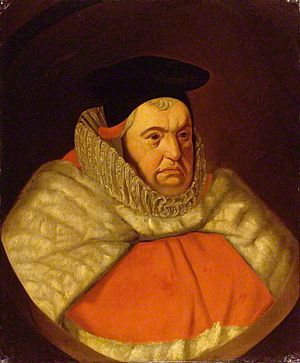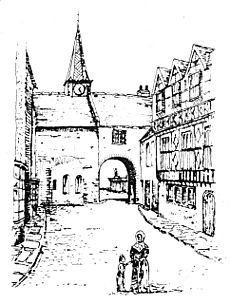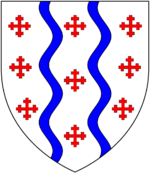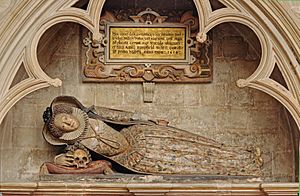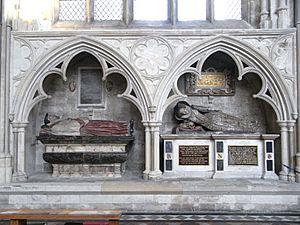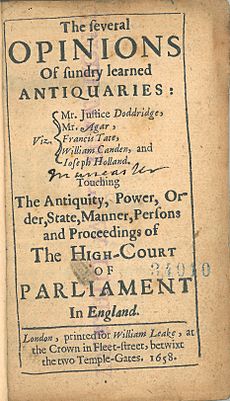John Doddridge facts for kids
Sir John Doddridge (born 1555, died 1628) was an important English lawyer and judge. He became a Justice of the King's Bench in 1612, which is a very high legal position. He also served as a Member of Parliament (MP) for Barnstaple in 1589 and for Horsham in 1604. Besides his legal work, he was interested in history and old things, making him an "antiquarian" and a writer. People sometimes called him "the sleeping judge" because he would close his eyes to listen very carefully to cases. He believed in the fairness of English common law and its connection to old customs.
He was considered one of the important people from Devon, mentioned by the writer John Prince in his book Worthies of Devon.
Contents
His Family and Early Life
John Doddridge's father was Richard Doddridge, a merchant from Barnstaple. The family name came from a place called Dodderidge in Sandford. Richard was a wool merchant who was born in South Molton. He moved to Barnstaple with his wife and eight children before 1582. Richard Doddridge became the Mayor of Barnstaple in 1589.
Richard Doddridge also worked in shipping. He owned a ship called Prudence, which was a privateer. This means it was a private ship allowed to attack enemy ships, like Spanish galleons, and take their goods. In 1585, Richard bought a large timber-framed house in Cross Street. This house, known as the "Doddridge House," was later passed down to his sons, Sir John and his brother Pentecost Dodderidge (who also became an MP and mayor of Barnstaple).
The "Doddridge House" was taken down around 1900 to build a post office. However, a room from the house with beautiful carved oak panels from 1617 was saved. It is now in the Barnstaple Guildhall and is called the "Doddridge Room." This room shows the initials "PD" and "ED" for Pentecost Dodderidge and his wife Elizabeth. Today, the room is used to display the town's valuable silver and the mayor's special items.
His Education
John Doddridge studied at Exeter College, Oxford. He earned his first degree there in 1577. Around the same time, he began his legal training at the Middle Temple, one of the four main law schools in London.
His Career as a Lawyer and Judge
In 1588, John Doddridge was elected as a Member of Parliament for Barnstaple. He also became an early member of the Society of Antiquaries, a group interested in history and old things. In 1602 and 1603, he gave lectures on law at New Inn.
In 1604, he became a serjeant-at-law, which was a very important and respected type of lawyer. He also became a legal advisor to Prince Henry, the son of King James I. Later that year, he was appointed Solicitor General, another high legal position.
From 1603 to 1611, he served as an MP for Horsham. He took part in an important discussion in 1606 about whether English and Scottish people born after King James I became king of both countries should have the same rights in both places. Doddridge believed they should not automatically have the same rights, and many agreed with him. However, the highest judge, Lord Chancellor Ellesmere, later decided that they should have the same rights.
Doddridge was knighted in 1607, which means he was given the title "Sir." In 1612, he became a Justice of the King's Bench, a top judge. The University of Oxford also gave him an advanced degree in 1614.
Unlike some other judges, Sir John Doddridge was willing to give his legal opinions in private to the king. He was involved in some important legal cases during his time as a judge. For example, he was part of a group that looked into whether Archbishop George Abbot could install new bishops after an accident during a hunting trip. He also helped decide a case where five knights were put in prison for not paying a special loan requested by the king. Doddridge supported the king's power in this matter.
Where He Lived
The Doddridge family had lived at Dodderidge in Sandford since the 1200s. Sir John Doddridge lived in the house his father owned in Cross Street, Barnstaple. He also had an estate called Bremridge, about 8 miles from South Molton. He rebuilt Bremridge around 1622. Much of his building still stands today. He also had a house in Exeter called Mount Radford, which his second wife used.
His final home near London was Great Fosters, near Egham, Surrey, where he passed away.
His Marriages
Sir John Doddridge was married three times, but he did not have any children.
- His first wife was Joan Jermyn.
- His second wife was Dorothy Bampfield, whose father was Sir Amias Bampfield. There is a special monument to her in the Lady Chapel of Exeter Cathedral.
- His third wife was Anne Culme.
Death and Burial
Sir John Doddridge died on September 13, 1628, at his house, Great Fosters. He was buried in the Lady Chapel of Exeter Cathedral. There are two monuments there, side-by-side, with statues of him and his second wife, Dorothy. His monument shows him lying down, dressed in his judge's robes, holding a legal document. Next to it is the statue of his wife.
His Heir
Since Sir John Doddridge had no children, his brother, Pentecost Dodderidge (who died around 1650), inherited his property. Pentecost's son, John Dodderidge (died 1659), then became the next heir.
His Writings
Sir John Doddridge wrote several books, which were published after he died. These include:
- The Lawyer's Light (1629) – a guide for law students.
- History of Wales, Cornwall, and Chester (1630) – a history book.
- A Compleat Parson (1630) – based on his lectures about church law.
- The English Lawyer (1631) – a guide for lawyers and judges.
- Law of Nobility and Peerage (1658) – about the laws concerning nobles.
Some shorter writings by Doddridge also appear in other collections. For example, he wrote about the size of England and the duties of heralds (officials who deal with coats of arms and ceremonies). A book called Dissertation on Parliament was published by his nephew, claiming to be his work, but it's not certain if he truly wrote it. Some other legal books have also been thought to be his work, but this is not confirmed.


